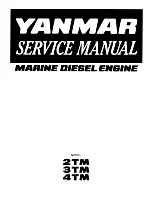
2200Q2JE-HO-KHM-N_2015.02.
Chapter 3 Installation
Ammonia Semi-hermetic Motor with K-series Compressor
3.2 Installation Work
3-2
3.2.3 Transportation
Should this product being lifted drop, there is a high risk of death or severe injury.
Provide sufficient protection such that no one can enter an area below this product
being lifted up.
For the mass of this product, refer to Table 2-1 in this manual Chapter 2 Section 2.3.1 "Standard
Specifications".
For the outer dimensions, refer to Section 2.3.3 "Outer Dimensions" in this manual Chapter 2.
1.
When lifting this product, be sure to prepare and use lifting devices and other proper tools capable
of lifting this product mass within the specified safety load limit.
2.
A sufficient space must be provided to ensure that the lifting work can be safely conducted.
3.
Make sure to check the wire ropes and belt slings before use. Carefully check the wire ropes for
any kink, knot, or broken strand, and the belt slings for any scar, abrasion, hooking scratch, or belt
peeling. Never perform the lifting work before it has been confirmed that the wire ropes and/or belt
slings have no problems.
If any doubt remains, ask a qualified specialist to check the condition.
4.
If only this product body is to be lifted, use the eye bolts on this product to hook the wire ropes
(refer to next page picture).
5.
If the unit base structure with this product to be lifted, use the eye bolts on the unit base structure to
hook the wire ropes. Never use the eye bolts on this product.
6.
Check that the transportation path is free from any obstacles that can hinder smooth transport,
according to the size of this product.
7.
Before lifting this product, check that the hook is positioned above the center of gravity of this
product.
8.
Before starting to lift up this product, instruct all the workers to be sufficiently away from the lifting
area.
9.
Just before starting to lift up, provide the coworkers with a sign (such as a call, hand signal, etc.) of
starting the lifting action. Do not start to lift up unless the sign (such as a call, hand signal, etc.) has
been fully acknowledged.
10.
Wind up the wire ropes slowly until shortly before this product leaves from the ground.
11.
Wind up the wire ropes again until this product leaves the ground, and check that this product is
not tilted. If it is tilted, return this product to the ground and correct the tilt. After that, restart the
lifting operation.
12.
Slowly lift up this product. A sudden lifting may cause damage to the wire ropes and/or other
hoisting tools or some part of this product.
13.
After the hoisting has started, check the condition to see that the wire ropes and other hoisting
tools are in normal condition. Check that this product is not tilted.
14.
When moving this product in the lifted condition, be sure to use guiding ropes.
15.
Evacuate people from the forward path and check the safety in the direction of the movement.
16.
Unless it is inevitable, do not bring this product above any safety passage.
17.
Do not place this product (unit) on a safety passage. The safety passages shall always be kept
unblocked.
18.
Before lifting down this product, clear the area from any obstacles. Make sure this product will not
be tilted or become unstable.
19.
When lowering this product, also notify the coworkers around the working area.
20.
Be sure to carefully and gradually lower this product so that it is not damaged by impact on the
ground.
21.
If this product body is to be placed on two or more blocks, properly adjust the height of each block
for this product to be stably leveled on the blocks.
Summary of Contents for K Series
Page 50: ... N4KHM30 N8KHM60 ...
















































